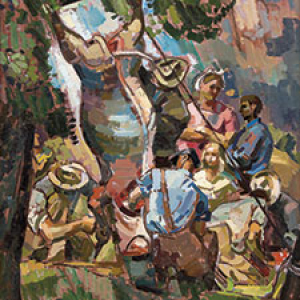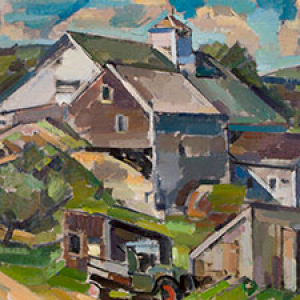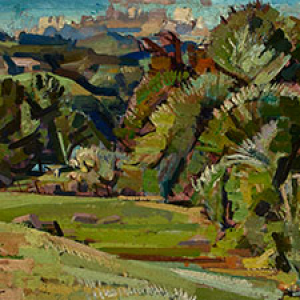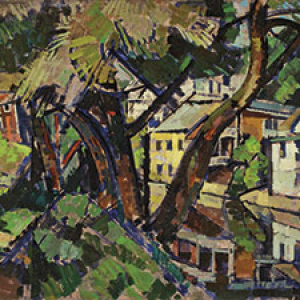September 26 – December 15, 2017
Herbert Barnett: Vermont Life and Landscape, 1940-1948 reexamines the contribution of this mid-century modernist painter through the subject matter and time period in which the artist’s distinctive style found its greatest expression: his Vermont landscapes of the 1940s. The exhibition was organized in consultation with the artist’s son and features works on loan from public and private collections.
Barnett was born and raised in Rhode Island and studied at the Rhode Island School of Design and the School of the Museum of Fine Arts in Boston. At the age of seventeen, he had his first solo show at a Boston gallery. After spending several years in Europe absorbing the Old Masters and avant-garde alike, Barnett divided his time in the late 1930s between New York, Boston, and Cape Ann, Massachusetts. In the 1940s, Barnett was head of the Worcester Museum School in Massachusetts, and spent his summers in Plainfield, Vermont. In the summers of 1941 and 1942, he taught painting at the University of Vermont, and from 1951 until his death in 1972, Barnett served as dean of the Art Academy of Cincinnati.
Combining a Cubist approach to structure and paint application with a deep interest in Renaissance and Baroque composition, Barnett’s Vermont paintings portray the winding paths of quarry towns, the patchwork of pastures, and aspects of daily farm life. When Barnett identified such a picturesque scene, he depicted it in a variety of media, from paintings and oil studies to drawings in ink, pencil, charcoal, and chalk. The exhibition is structured around these multiple expressions of his favorite themes.
For example, several works in the exhibition depict the fields of the Orton family, the proprietors of the Vermont Country Store. When summering in Plainfield, the Barnetts stayed in a hillside cottage overlooking the Ortons’ pastures in neighboring Marshfield. A grouping of four works on this subject gives the museum visitor a revealing glimpse into the artist’s process and development. Barnett’s renderings of the same scene in different color palettes and styles represent the ever-shifting quality of light caused by the temperamental New England weather, as well as the artist’s formal experimentation.
The Fleming Museum’s relationship with Herbert Barnett dates back to his time spent teaching at UVM. In 1942, the Fleming featured Barnett’s work in a two-person exhibition with Barse Miller. In 1978, a few years after Barnett’s death, the Fleming mounted a solo exhibition. Several works in the current exhibition were included in one or both of those shows.
Dressing Down the Bull, Plainfield, Vermont (detail)

Herbert Barnett (American, 1910-1972), about 1941.
Oil on masonite.
33 x 27 in.
Collection of J. Brooks Buxton ’56, Promised Gift
New England Farm (detail)

Herbert Barnett (American, 1910-1972), about 1941.
Oil on canvas
24 x 36 in.
Collection of J. Brooks Buxton ’56, Promised Gift
Orton’s Pasture (detail)

Herbert Barnett (American, 1910-1972), about 1941.
Oil on masonite.
16 x 36 in.
Lyman Orton Collection – Lost Vermont Images
Reflections, Plainfield, Vermont (detail)

Herbert Barnett (American, 1910-1972), 1944
Oil on fiberboard.
23 7/8 x 36 1/8 in.
Collection of the Worcester Art Museum,
Gift of Lawrence R. McCoy
The exhibition is accompanied by an illustrated brochure with essays by the artist’s son Peter Barnett and Fleming curator Andrea Rosen.